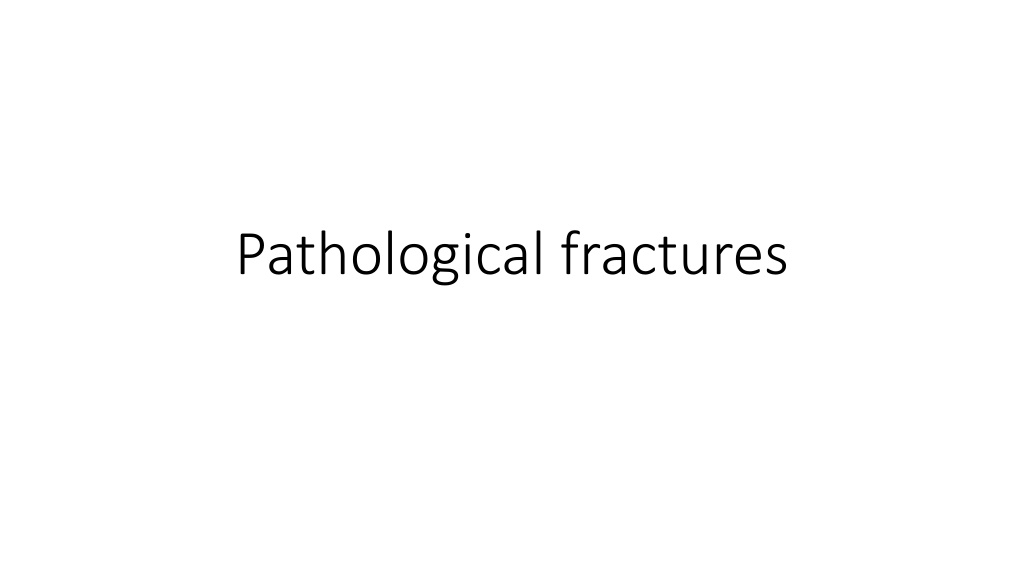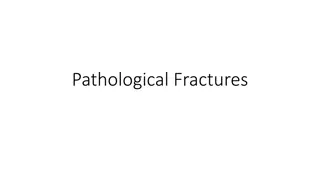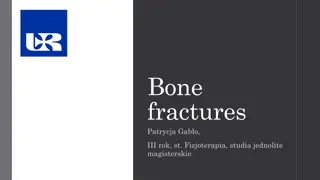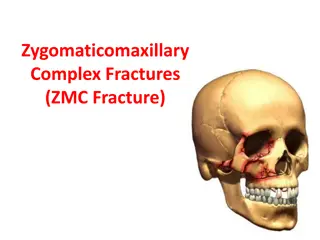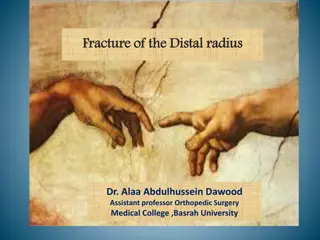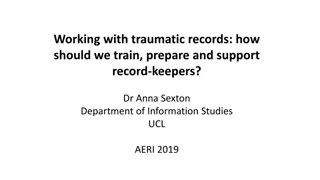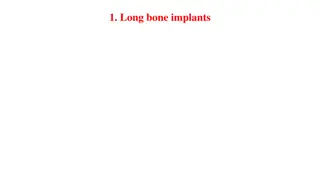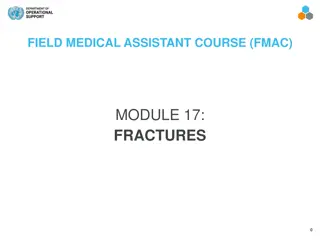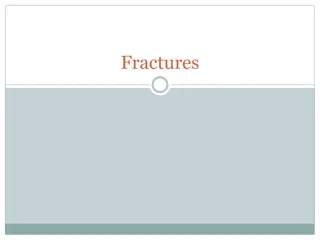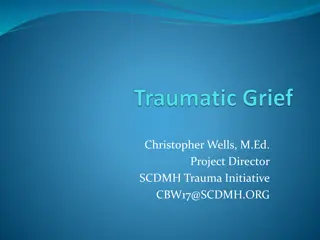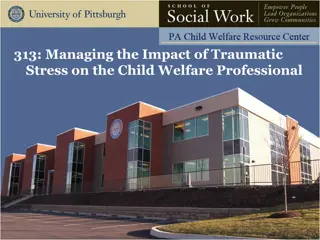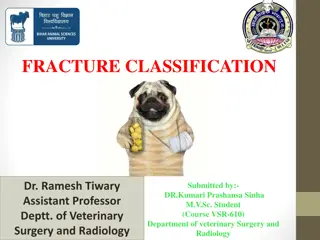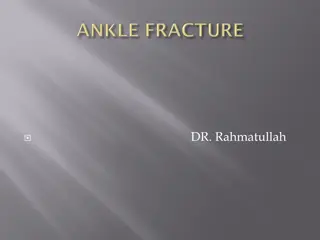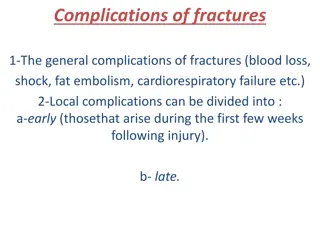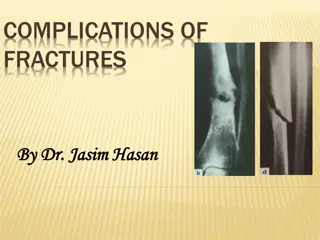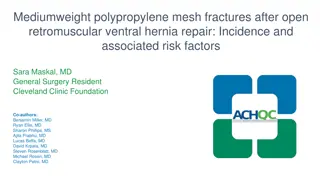Understanding Fractures: Traumatic vs. Pathological and Modeling Options
Defining the distinction between traumatic and pathological fractures, exploring the relationship between non-traumatic fractures and underlying bone pathologies, and discussing modeling options for classifying fractures. Stress fractures, insufficiency fractures, and the causes of pathological fractures are also elucidated.
Download Presentation

Please find below an Image/Link to download the presentation.
The content on the website is provided AS IS for your information and personal use only. It may not be sold, licensed, or shared on other websites without obtaining consent from the author. Download presentation by click this link. If you encounter any issues during the download, it is possible that the publisher has removed the file from their server.
E N D
Presentation Transcript
General questions - Should we consider ALL fractures as traumatic (e.g. pathological fractures are minor trauma to weakened bone)? [NOTE: This has been the historical representation in SNOMED CT] - Can we infer that all non-traumatic fractures are pathological fractures (i.e. requires some predisposing bone pathology)? - If the distinction between traumatic and pathological fractures needs to be made, how do we interpret the meaning of Fracture of X ? Do we need specific Traumatic fracture of X concepts?
Options for modeling Pathological fracture Modeling Option Pros Cons Model as traumatic injury Consistent with the historical representation Classifies Pathological fracture of X as subtype of Fracture of X Distinguishes pathologic fractures from true traumatic fractures Consistent with literature stating these fractures are non-traumatic Essentially the same as using spontaneous event, but does not eliminate the use of traumatic events in the presence of other conditions (e.g., osteoporosis) Essentially the same as modeling without an Event Conflicts with literature that considers pathologic fractures non-traumatic Model as Spontaneous event Not all pathologic fractures are spontaneous (e.g., falls) Makes pathological fractures sibling to Fracture of X Model without an Event relationship Makes some pathological fractures sibling to Fracture of X Model using DUE TO predisposing condition Makes pathological fractures sibling to Fracture of X Does not classify under the predisposing condition Does not classify under the predisposing condition Model using DUE TO Traumatic event AND DUE TO predisposing condition Model using DUE TO Traumatic event and co-occurrent with predisposing condition Classifies Pathological fracture of X as subtype of Fracture of X Classifies Pathological fracture of X as subtype of Fracture of X Classifies under the predisposing condition Classifies under the predisposing condition Conflicts with literature that considers pathologic fractures non-traumatic Model using DUE TO Spontaneous event and co-occurrent with predisposing condition Model without an Event relationship but with and co- occurrent with predisposing condition Makes pathological fractures sibling to Fracture of X Classifies under the predisposing condition Makes pathological fractures sibling to Fracture of X
Variable definitions for stress fractures and insufficiency fractures and their relationship to pathological fracture * *Fractures through abnormal bone are called pathological fractures. Probably the most common cause of this is an underlying tumor, either benign or malignant. However, almost any underlying process of bone that weakens the bone can lead to a pathological fracture. Therefore, one should also consider infection, osteomalacia, and Paget s disease, among other causes.
Definitions from UptoDate Fracture Fracture refers to the breaking of a bone. Complete fractures divide the affected bone into two or more pieces, while partial (incomplete) fractures do not extend through the cortex. An example of an incomplete fracture is the "greenstick" fracture, in which the convex side of a long bone is disrupted while the concave surface remains intact. These are most common in children. Stress fracture A stress fracture occurs when a bone breaks after being subjected to repeated tensile or compressive stresses, none of which would be large enough individually to cause the bone to fail, in a person who is not known to have an underlying disease that would be expected to cause abnormal bone fragility. Stress reaction A radiographic finding on computed tomography (CT), magnetic resonance imaging (MRI), or bone scan of increased metabolic activity at a site of bone turnover that does not yet show cortical disruption. Stress reactions are often asymptomatic but considered a precursor to a stress fracture. Bone stress injury A term that includes all clinically symptomatic stress reactions and stress fractures. Insufficiency fracture An insufficiency fracture occurs when the mechanical strength of a bone is reduced to the point at which a stress that would not fracture a healthy bone breaks the weak one. The condition that causes reduced bone strength typically does so throughout the skeleton (eg, osteoporosis, osteomalacia, or osteogenesis imperfecta) but may be more localized (eg, demineralization in a limb due to disuse). Insufficiency fractures due to osteoporosis, pseudofractures, and radiolucent lines seen in the bones of patients with osteomalacia are reviewed elsewhere. (See "Clinical manifestations, diagnosis, and evaluation of osteoporosis in postmenopausal women" and "Osteoporotic thoracolumbar vertebral compression fractures: Clinical manifestations and treatment" and "Epidemiology and etiology of osteomalacia".) Pathologic fracture A pathologic fracture is due to a localized loss of strength in a bone from a disease process immediately underlying the bone. Examples of pathologic fractures include those that occur at sites of bone tumors (primary or metastatic), bone cysts, and infections.
Additional definitions Insufficiency fractures (IFs) are a subtype of stress fractures commonly associated with osteoporosis and Vitamin D deficiency. These nontraumatic fractures often occur in the pelvis and spine, but the involvement of other unusual sites is also not very uncommon. Insufficiency fractures are a type of stress fracture, which are the result of normal stresses on abnormal bone. Osteoporosis is the most common cause of insufficiency fractures Disrupted bone mineral homeostasis: osteoporosis, hyperparathyroidism, diabetes mellitus, osteomalacia Bone remodeling: Paget disease, osteopetrosis Collagen formation: Marfan syndrome, fibrous dysplasia Medications: glucocorticoids, chemotherapy Radiation therapy Pathological fractures are fractures that occur in abnormal bone and occur spontaneously or following minor trauma that would not otherwise fracture biomechanically normal bone
125605004 |Fracture of bone (disorder) 125605004 |Fracture of bone (disorder)| is currently a descendant of Traumatic injury. The concept 19130008 |Traumatic abnormality (morphologic abnormality)| will be going away in the Jan 2021 release, so the explicit identification of fractures as traumatic will be gone and require the use of the DUE TO <<Traumatic event to identify them as traumatic injuries We have called all fractures traumatic unless specifically stated not to be. If we model 125605004 |Fracture of bone (disorder)|using due to Traumatic event and we consider Pathological fracture to be nontraumatic, Pathologic fracture would no longer be subsumed under Fracture of bone which is not intuitive
Additional thoughts If not using due to spontaneous event to define Pathological fracture (disorder) then need to maintain 22640007 |Pathologic fracture (morphologic abnormality)|in order to distinguish from a fracture of unknown cause Model 125605004 |Fracture of bone (disorder) without a due to Traumatic event relationship. This would result in all concepts with an ASSOCIATED MORPHOLOGY <<72704001 |Fracture (morphologic abnormality)| classifying under it, but only those with the DUE TO Traumatic event will also classify as Traumatic injuries. This would only be able to be tested after all of the uses of traumatic abnormality have been remodeled and Traumatic abnormality was inactivated. An identified issue is that there are many Fracture of [X] bone conceptsin SNOMED CT. Would these be treated as traumatic or nontraumatic or traumatic? If traumatic would it not be confusing if the current FSNs of Fracture of [X] bone is considered a traumatic fracture while Fracture of bone is a traumatic or nontraumatic fracture?
